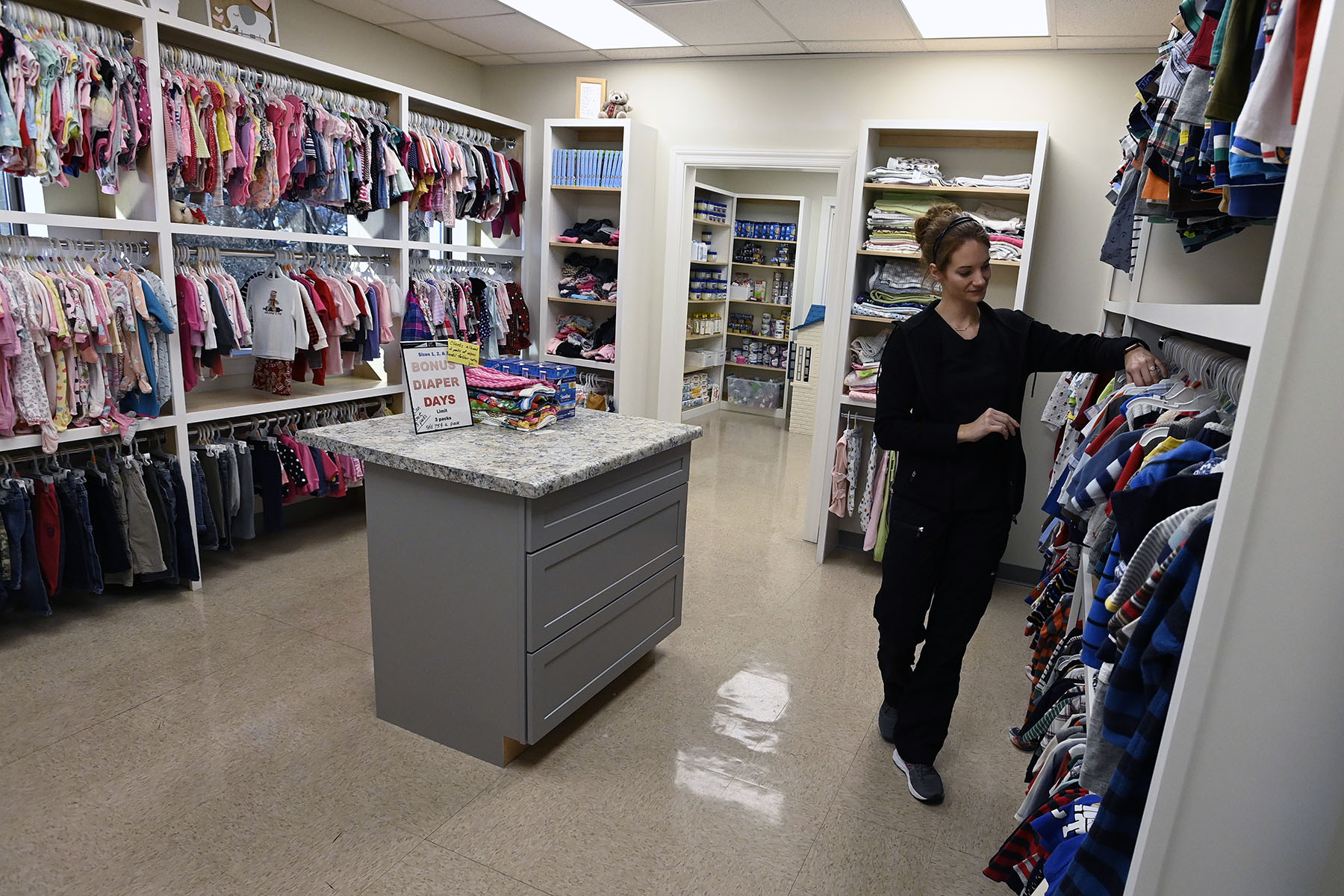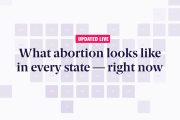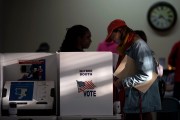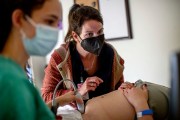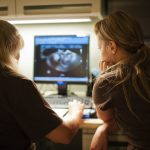After the U.S. Supreme Court overturned Roe v. Wade last year, Louisiana Republican state Sen. Beth Mizell looked for a way to address her state’s abysmal record on infant and maternal mortality, preterm births and low birth weight. Louisiana has one of the nation’s strictest abortion bans, with no exceptions for rape or incest.
Mizell and her colleagues borrowed an idea from neighboring Mississippi: a state tax credit program that sends millions each year to nonprofit pregnancy resource centers, also called crisis pregnancy centers. They’re private anti-abortion organizations, often religiously affiliated, that typically offer free pregnancy tests, parenting classes and baby supplies. They are not usually staffed by doctors or nurses, though some offer limited ultrasounds or testing for sexually transmitted infections.
“I see [pregnancy resource centers] as a touchpoint for pregnant women who may not know where to go for services or where to begin,” Mizell said. Louisiana has roughly 30 to 40 pregnancy resource centers scattered across the state. “If we don’t use everything with an open mind to give women the services they need, we’re only hurting women in our state.”
Legislators in states with some of the strictest abortion bans are pouring millions into pregnancy resource centers, painting them as solutions to poor birth outcomes and the lack of access to adequate prenatal and postpartum care. But while Republican lawmakers have increasingly positioned pregnancy resource centers as a backstop for maternal health care, critics say those taxpayer dollars should be used to shore up more comprehensive medical and social services.
-
Read Next:
Mizell’s bill, which was signed into law in June and went into effect August 1, allows both individuals and corporations to claim an income tax break for donations made to pregnancy resource centers, which the law calls “maternal wellness centers.” The tax credits are capped at $5 million per year. Mississippi passed a similar tax credit law last year and expanded its cap this year to $10 million annually.
In 2017, Missouri became the first state to issue tax credits for donations to pregnancy resource centers and it recently removed its limit on how many tax credits the state can issue. Alabama, Kansas and Nebraska considered their own tax credits in this year’s legislative sessions.
The tax breaks are much larger than those awarded for donations to most other types of charities.
Some critics of Louisiana’s new law question its cost, when so many residents struggle to get prenatal care.
“We have many areas around the state where there are no obstetricians, no birthing centers and it’s very difficult for people to get access to prenatal care,” said Michelle Erenberg, executive director of Lift Louisiana, a reproductive rights advocacy organization.
“I think these centers are trying to rebrand as being maternal care centers. But they’re not providing any actual medical services. They’re not licensed. They’re not regulated. Is that a good value for $5 million a year of Louisiana’s tax dollars?”
‘What could be bad?’
Matt Mitchell, the CEO of Oasis Medical Center in Corinth, Mississippi, calls his center “the best first stop for pregnancy concerns.”
Located in the rural northeast corner of the state, Oasis is a pregnancy resource center that does not offer comprehensive medical care, but does provide pregnancy tests, non-diagnostic ultrasounds, testing for sexually transmitted infections, adoption referrals, parenting classes and community resource referrals, all for free.
Mitchell doesn’t think his center’s role has changed since the U.S. Supreme Court overturned Roe v. Wade, he told Stateline in a written statement, “but I think more people are aware of the important role we play.”
The Southeast is home to about 900 pregnancy resource centers, more than a third of the national total, according to the Crisis Pregnancy Center Map created by University of Georgia researchers Andrea Swartzendruber and Danielle Lambert.
“From a public health perspective, I think awareness about what crisis pregnancy centers are, their mission and goals, is really low,” Lambert said. Her work with Swartzendruber has focused on the public health impact of pregnancy resource centers, which they found tend to be more common in states with abortion bans.
“When we talk to policymakers and advocacy groups,” Lambert said, “the narrative is, ‘What could be bad about helping women who are in need and pregnant?’ They have images on their websites of people in white coats.”
Swartzendruber has noticed a “significant increase” recently in the number of pregnancy resource centers that offer limited, non-diagnostic ultrasounds or have changed their names in ways that suggest they provide health care. “But we’ve found on the whole, the services they’re offering aren’t in line with national medical standards,” she said.
Louisiana’s new tax credit law requires “maternal wellness centers” to provide certain resources to their clients, including a list of the closest OBGYNs, as well as information on applying for Medicaid and federal food assistance programs. And, as with the Mississippi and Missouri laws, the centers can’t be associated with abortion providers or refer clients for abortions.
-
Read Next:
“If I had put a requirement on the bill that they had to have a licensed medical provider there, I wouldn’t have had buy-in from the pregnancy resource centers because that’s too much of a financial burden on them and that’s not the role of the center,” Mizell said.
Critics of pregnancy resource centers say they often use a bait-and-switch approach, targeting vulnerable people by offering “abortion consultations” or “pre-abortion screenings” that spread false claims about the dangers of abortion. Swartzendruber and Lambert said they’ve documented instances of centers providing misinformation about reproductive health, including about contraceptives.
Some centers, such as Oasis in Mississippi, offer “abortion reversal” treatment. It’s a controversial practice that uses doses of the hormone progesterone to stop a medication abortion after a patient has completed the first part of the two-step abortion process. The American College of Obstetricians and Gynecologists says the treatment is not supported by science and does not meet clinical standards.
A small 2019 study designed to test the effectiveness of abortion reversal was halted after three of the 12 participants required a trip via ambulance to the hospital to be treated for severe bleeding.
But Mizell said she hasn’t seen evidence of danger or misinformation from the centers.
“I just think it’s a paper tiger of an argument,” she said. “We have 40-something of these centers all over the state, including in the rural areas. They’re not intimidating, and they have all of these buckets of information available and can point the pregnant person in the right direction.”
More bang for your buck
The tax credit programs are structured to make donations to pregnancy resource centers far more lucrative for donors than contributions to other types of charities, said Lillian Hunter, a research assistant at the Urban-Brookings Tax Policy Center who has studied how states have amended their tax policies in the wake of the Dobbs v. Jackson Women’s Health Organization ruling that struck down constitutional protections for abortion.
This is because a tax credit allows filers to reduce their taxes owed, as opposed to reducing their taxable income.
If you’re a Louisiana resident and you donate $500 to a pregnancy resource center and apply for a state tax credit, you’ll reduce the total amount of state taxes you owe by $250, because the tax credit for that donation is 50 percent of the donated amount. If you donated that same $500 to any other charitable organization, you’d save yourself just $21.25. This is because your donation would reduce your taxable income by $500, and Louisiana’s top state tax rate is 4.25 percent.
“It really privileges this type of donation over donations to every other charity,” Hunter said. And while a handful of states have tax credits for other types of charitable donations, “they’re not typical.”
For example, Missouri offers a 50 percent tax credit for donations of $100 or more to diaper banks. Its tax credit for donations to pregnancy resource centers is 70 percent, which means a donation of $100 to a diaper bank would result in a $50 reduction in state taxes, but the same donation to a pregnancy resource center means a $70 reduction.
After Missouri lawmakers removed the limit on how many tax credits the state could issue for donations to pregnancy resource centers, Missouri authorized more than $7 million in tax credits for the centers in the first quarter of 2022, according to an analysis by ProPublica. That jump was more than three times higher than in any other quarter.
In Mississippi, Mitchell said donations to his center increased after the state passed its tax credit law last year, and he hopes more businesses and individual taxpayers will take advantage of the expanded tax credit this year.
Transparency and oversight
It’s hard to say what the impact of the tax credits will be on birth outcomes. States with strict abortion bans and high numbers of pregnancy resource centers, mostly in the Southeast and Midwest, already tend to be states with some of the worst birth outcomes.
“My biggest concern is that states enact these tax credits and don’t invest in programs that we know work, like expanding earned income or child tax credits,” said Hunter, the research assistant at the Urban-Brookings Tax Policy Center. They might spend less on maternal health or food assistance programs, she said, “because they already have something they can point to that they’re doing to help families.”
The principal author of Mississippi’s tax credit expansion this year was Republican House Speaker Philip Gunn, a vocal opponent of abortion rights. Last year, he twice blocked bipartisan efforts to expand Medicaid coverage in Mississippi for mothers up to 12 months postpartum.
Aside from the new tax credit programs, at least 18 states directly fund pregnancy resource centers through state grants and by funneling federal welfare dollars to them — and many have bumped up their funding, according to Equity Forward, a research and watchdog group focused on reproductive rights.
Some notable increases in state spending on pregnancy resource centers from 2022 to 2023 include Florida’s increase from $4.5 million to $25 million and Tennessee’s from $3 million to $20 million, according to Ashley Underwood, director of Equity Forward.
The cascade of funding is thanks, in part, to organized national pregnancy center groups that “shop tactics across state lines,” she said. She pointed out that Louisiana’s law even requires pregnancy resource centers to be affiliated with a national pregnancy center organization before they can go on the state-approved donation list.
The Louisiana law also requires pregnancy resource centers to self-report that they meet the criteria to be eligible for tax-credit donations, including that they offer information about local obstetricians and how to apply for government assistance programs. But the law does not give the state department of health regulatory authority over the centers.
“I just think that if our tax dollars are being put towards this, whether it’s a direct program or a tax credit program, there needs to be more requirements that they show they’re actually doing something to improve maternal health outcomes,” Lift Louisiana’s Erenberg said.
Stateline is part of States Newsroom, a nonprofit news network supported by grants and a coalition of donors as a 501c(3) public charity. Stateline maintains editorial independence. Contact Editor Scott S. Greenberger for questions: [email protected]. Follow Stateline on Facebook and Twitter.
